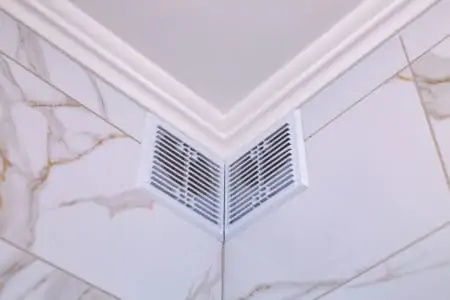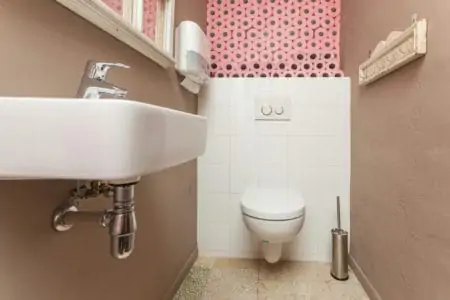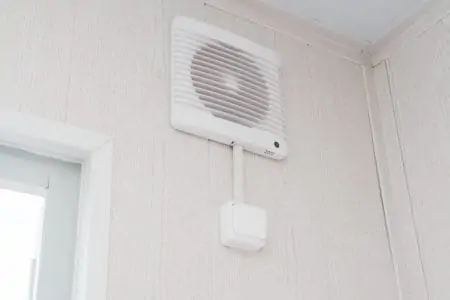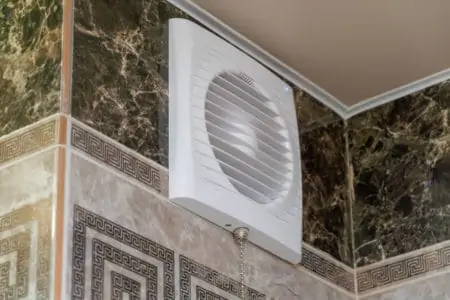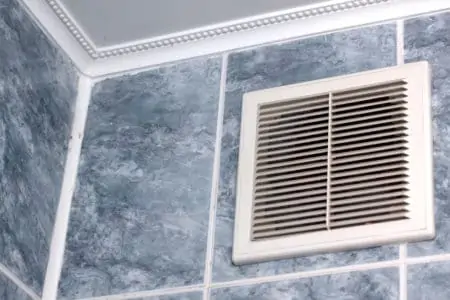According to the National Electrical Code, if you have a bathroom without a window, you need an exhaust fan. The correct bathroom fan sizing for your space is crucial in keeping moisture and mold at bay.
Many factors determine how to size a bathroom exhaust fan, so we decided to give you the straight facts.
Key Takeaways
- Bathroom exhaust fans are crucial for reducing moisture, mold, and odors.
- For bathrooms under 100 square feet, allocate 1 CFM (Cubic Feet Per Minute) per square foot.
- For larger bathrooms, add CFM requirements for each fixture (e.g., toilet: 50 CFM, shower: 50 CFM).
- Avoid using a 2-inch pipe for bathroom fans, as it may hinder effectiveness and add noise.
Do I Need a Bathroom Exhaust Fan?
If you have a bathroom with a window that opens, you don’t need a bathroom exhaust fan. However, you are required to have one if you lack basic ventilation.
But that’s not the whole story. It might be better to ask about the advantages of a bathroom exhaust fan. So what are they?
Keeps Moisture at Bay
Steam from baths and showers linger in the air, making all the surfaces damp. Damp air causes respiratory problems and could harbor pollutants that remain in the ideal moist conditions.
Moisture also causes unsightly staining to your fixtures and tiles, especially attacking the grout and the silicone fillers. Nothing ages a bathroom more than black mold stains.
Keeps Mold at Bay
Damp also creates mold, and mold is hazardous to those suffering lung and respiratory diseases. Asthma, emphysema, and other ailments worsen when mold spores get inhaled. Also, mold is unsightly and quickly takes hold, ruining your bathroom.
You can use chemicals to keep it at bay, but nothing beats good ventilation.
Keeps Odors at Bay
We all know about toilet odors, so to keep them in check, a bathroom exhaust vent extracts the smells to the outside, leaving your space smelling fresh.
Keeps Cold at Bay
On chilly days, opening the window in your bathroom to release moisture allows the cold in. This impacts your heating bills and puts undue strain on your heating system. A bathroom exhaust fan does this for you without the need to cool the house down.
What Is the Building Code for Venting a Bathroom Fan?
The Environment Protection Agency (EPA) recommends that your bathroom requires a mechanical ventilation system if you have a bathtub, a shower, or a similar source of moisture. The fan must provide a minimum of 50 CFM (Cubic Feet Per Minute) intermittent use and 20 CFM continuous use.
CFM is the standard measurement of airflow, showing how effective your bathroom fan is at changing the air in the room. The recommendations call for a minimum of 8 air exchanges per hour. The more CFMs, the faster the air is removed and the cleaner the air.
If your bathroom has a window, it must open to an area of at least 4 percent. The National Electrical Code (NEC) also mirrors this recommendation.
Is More CFM Better for a Bathroom Fan?
It’s always advisable to oversize your fan. It gives you some flexibility to upscale moisture extraction should you need it, and at some point you may remodel your bathroom, adding features like a jacuzzi or a jet tub.
Future-proofing is a good thing to save on the cost of upgrading the fan exhaust system. Increasing the fan’s CFM values will give you this flexibility, but don’t overcompensate too much, or you will incur unnecessary additional costs in installation and energy use.
Bathroom Fan Sizing Chart
Here’s a handy chart to get you started on the right path:
| Bathroom Size | Minimum CFM Required |
| Less than 50 square feet | 50 CFM |
| 50 to 100 square feet | 1 CFM per sq. feet of floor space |
| More than 100 square feet | Add CFM requirements for each fixture: Toilet: 50 CFM Shower: 50 CFM Bathtub: 50 CFM Jet tub: 100 CFM |
Bathroom Fan Sizing Methods
There are specific ways to calculate the CFM values of your bathroom exhaust fan to match your space.
Standard Bathrooms (Under 100 Square Feet)
Standard fan sizing refers to bathrooms that are 100 square feet or less. The guide is to allocate 1 CFM for every 1 square foot you have available. To get the square footage of your bathroom, you simply multiply the length by the width.
If your bathroom measures 8 ft by 7 ft, you multiply the two, and you get a square footage of 56 feet. That means you need a fan with a minimum CFM of 54. Exhaust fans start at 50 CFM, so if you have a bathroom that’s less than 50 square feet, you still need a 50 CFM fan.
It’s always a good idea to oversize slightly, so a 56-square foot bathroom could accommodate a 60 or 70 CFM fan. You might also want to consider the fixtures you have. Jet tubs and alcoves make extraction more difficult, so consider getting a second fan.
The position of the fan is crucial too. You want it somewhere central if you have a smaller space. If you have a more significant bathroom, with the bath and shower on one side of the room, it won’t work if you place the fan at the furthest point away from the fixtures.
Large Bathrooms (Over 100 Square Feet)
As per the handy chart above, you should size your exhaust fan according to the number and type of fixtures you have. It’s a simple calculation to make. Just add up the CFM values for each fixture to determine the fan capacity.
Here’s an example:
- Bathtub: 50 CFM.
- Shower: 50 CFM.
- Toilet: 50 CFM.
- Jet tub: 100 CFM.
If your bathroom has a toilet and a shower, you should get a fan of 100 CFM. Likewise, if you have all of the above fixtures, allocate for a 250 CFM fan.
Another way to calculate larger room capacities is to take into account the ceiling height. Some bathrooms have ceilings well over 8 feet high.
For this calculation, you multiply the square footage by the ceiling height and then divide by 60 minutes, and then multiply by 8 (the number of recommended air exchanges per hour).
Something like this:
- 120 square feet multiplied by 10 feet (ceiling height) equals 1,200.
- 1,200 divided by 60 minutes equals 20.
- 20 multiplied by 8 air exchanges per hour equals 160 CFM.
Bathroom Fan Sizing FAQs
Size Matters
Getting the fan size right to fit your space is crucial in reducing moisture, mold, and odors. It keeps your bathroom protected from the ravages of daily use and reduces harmful pollutants from circulating around your home.
Think about the space, the type of fixtures you have, and the placement of the exhaust fan. Get all these elements right, and you will succeed in correctly sizing your bathroom fan.
